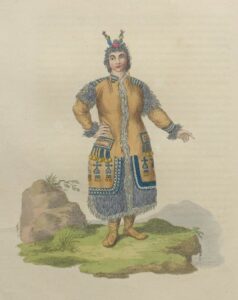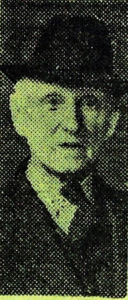The James Dunn Collection, Blackburn with Darwen Library and Information Service

Edward Harding, Costume of the Russian Empire, London, 1811, printed by Thomas Bensley for John Stockdale, hand-coloured engravings, ink on paper. The James Dunn Collection, Blackburn with Darwen Library and Information Service.
26 May 2020
By Dr Cynthia Johnston, Institute of English Studies, School of Advanced Study, University of London
James Dunn (1857-1943), a draper of Montague Street, Blackburn, gave his collection of rare books, historical documents and autograph manuscripts to the Blackburn Library before his death. The gift was an extraordinary one, accepted with enthusiasm at a specially convened meeting of the Library committee. The collection contains over 500 items which reflect Dunn’s wideranging bibliographic interests. There is a strong representation of eighteenth-century prints, both English and French, but with particular emphasis on the French Rococo material from copperplate engravings that Dunn sought out during his frequent book-buying expeditions to France, and Paris in particular. The works of Claude Gellée (le Lorrain), Charles-Dominique-Joseph Eisen, François Boucher, Hubert-François Gravelot and JeanMichel Moreau are all represented. A fine edition of Edward Donovan’s The Natural History of British Birds, printed in London in 1799, is characteristic of the type of work that appealed to Dunn in the British as opposed to Continental context.
Dunn, like his contemporary Blackburnian Robert Edward Hart, is clearly interested in early English printing and his collection has some rare examples of this material. Dunn knew of only one other surviving copy of A Ryght frutefull Epystle, deuysed by the moste excellent clerke Erasmus in laude and prayse of matrymony, published in 1536. The English Short Title Catalogue does not yet record Blackburn’s copy of Rembert Dodoens’ A Niewe herball, published in 1578, nor the imperfect copy of The Saint Albans Chronicle, catalogued in the Dunn collection as The Cronicles of Englonde, printed by Wynkyn de Worde in London in 1515; there are only 4 other copies of this book recorded in the UK. Dunn has a particularly keen interest in early editions of the collected works of Geoffrey Chaucer. Th ere are three in the collection, all printed in London respectively by John Kingston for John Wight in 1561, the William Thynne edition printed by William Bonham in 1542, and the Adam Islip production edited by Thomas Speght in 1598.

James Dunn, from his obituary in the Northern Daily Telegraph, Thursday 16th December, 1943.
Dunn appears to have been less interested in literature than history, and the poetry and prose that is represented in the collection is overwhelmingly from the eighteenth century, like his selection of fine art prints. William Blake is an interest, and the importance of Blake’s engravings to his work makes his appeal to Dunn predictable. The works of Thomas Gray, Daniel Defoe, Oliver Goldsmith, Samuel Butler, Robert Burns, Alexander Pope, Rousseau and Voltaire comprise the eighteenth-century material along with James Thomson’s, The Seasons, a clear favourite in several editions. With Sterne, Smollet and Milton, Dunn edges into the nineteenth century.
Dunn’s nineteenth century material is scant, with the exception of his enthusiasm for the work of Charles Dickens, particularly with regard to the work of Dickens’ illustrators George Cruikshank, ‘Phiz’ (Hablot Knight Browne) and George Cattermole. Perhaps the most intriguing Dickensian material in the collection is a volume of autograph correspondence between Charles Dickens, Jr. and Percy Fitzgerald. Fitzgerald was a prolific and ambitious Irish playwright, novelist, biographer as well as a sculptor, who proudly counted himself as one of Charles Dickens Sr.’s ‘Young Men’. Dickens mentored these young writers and used their material to fill the pages of his magazines, particularly Household Words. Leaved into the pages of letters between Fitzgerald and ‘Charlie’ Dickens Jr., is a plot written on a piece of notepaper from Dickens Sr.’s home, Gad’s Hill Place. The plot is unsigned and undated. The hand is neither that of Dickens nor Fitzgerald. The author of this Dickensian plot featuring ‘a lonely man’ who ‘goes down to cathedral town’, two sisters, bailiffs and an ‘ill-conditioned youth’ who has a ‘great lawsuit’, is, as of yet, unidentified.